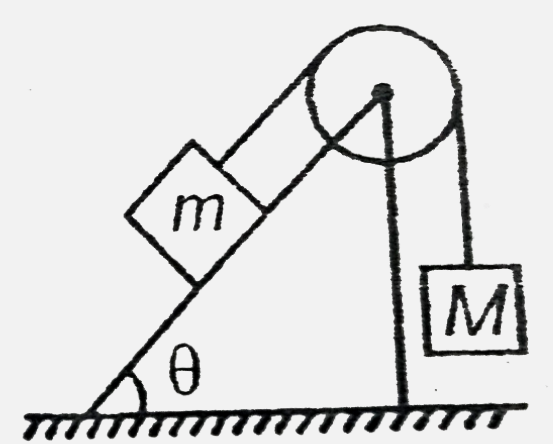The system shown is released from rest. Mass of ball is m kg and that of wedge is M kg respectively. When ball reaches at highest point on other side of the wedge, velocity of ball and wedge is (initially wedge is kept at rest against a wall and there is no friction anywhere) :

M√2gRm+M
M√2gRM
Mm√2gR
m√2gRm+M
The correct Answer is:D
Let h : height gain by ball above the bottom
⇒ Wedge will not move till the ball reaches at bottom with velocity √2gR
⇒m√2gR=(m+M)V⇒m√2gRm+M

Similar Questions
Knowledge Check
In the system shown, the initial acceleration of the wedge of mass 5M is (there is no friction anywhere)
 AZeroB2g/23C3g/23DNone
AZeroB2g/23C3g/23DNoneIn the system shown, the initial acceleration of the wedge of mass 5M is (there is no friction anywhere)
 AzeroBg/2Cg/3Dg/4
AzeroBg/2Cg/3Dg/4In the system shown block is released from rest on the inclined surface of the wedge. The acceleration of the wedge will be (assume friction to be absent)
 Ag5Bg4Cg3Dg2
Ag5Bg4Cg3Dg2
In the system shown, the initial acceleration of the wedge of mass 5M is (there is no friction anywhere)

View SolutionA particle of mass m is released from rest from a point A of a wedge of mass 4m free to slide on a frictionless horizontal plane.The particle slides down the smooth face AB of the wedge.When the velocity of the wedge is 0.2m/s the velocity of the particle in m/s relative to the wedge is
View SolutionA block of mass m is released from a wedge of mass m as shown in figure . Find the time taken by the block to reach the end of the wedge.

View SolutionA block of mass m is released from a wedge of mass m as shown in figure . Find the time taken by the block to reach the end of the wedge.

View SolutionWedge shown in the figure is fixed . System is released from rest (Neglect friction )

View Solution

